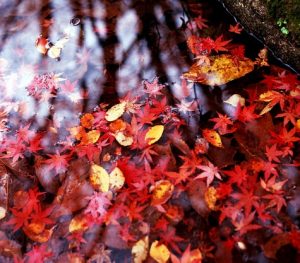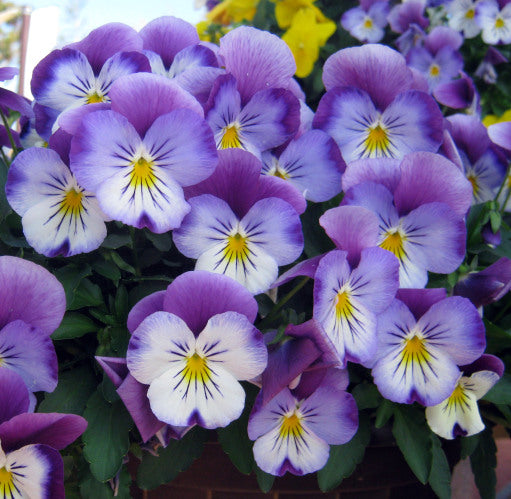 Autumn’s fallen leaves are like a big FREE load of organic fertilizer strewn about our yards. If the nutrients in the leaves were bagged and sold as fertilizer, they’d command a hefty price. But, left where they fall, leaves can mess up rock lawns, smother grass lawns, blow across walkways, and annoy the neighbors. Every year savvy gardeners invest a bit of sweat- equity to claim this autumn bounty for their landscapes. They rake up the fallen leaves and turn them into compost. So, let’s enjoy the season’s glorious colors, then collect the fallen leaves, compost them, and give our gardens a taste of nature’s richest soil amendment. But before heading out to the yard with rake in hand, ponder this list:
Autumn’s fallen leaves are like a big FREE load of organic fertilizer strewn about our yards. If the nutrients in the leaves were bagged and sold as fertilizer, they’d command a hefty price. But, left where they fall, leaves can mess up rock lawns, smother grass lawns, blow across walkways, and annoy the neighbors. Every year savvy gardeners invest a bit of sweat- equity to claim this autumn bounty for their landscapes. They rake up the fallen leaves and turn them into compost. So, let’s enjoy the season’s glorious colors, then collect the fallen leaves, compost them, and give our gardens a taste of nature’s richest soil amendment. But before heading out to the yard with rake in hand, ponder this list:
Ten Things to Do with Fallen Leaves
- Make a big pile of leaves in your front yard — a BIG pile — and jump around in it! Even my dogs enjoy the action. When your neighbors stop and stare, invite them to join you. Include grandchildren to create lifelong memories for them and for you.
- Run your mower back and forth through a layer of leaves to break them up, and then use the pulverized leaves as mulch over your perennial garden.
- Contact your city or county office to find out if there is a leaf-composting project in your area. Find out when you can start picking up compost.
- Take long walks around the neighborhood and make a mental note of very tidy yards with big trees. These people probably rake and bag their leaves. Contact them and ask if you can have their leaves for your compost pile. The answers are almost always “yes”.
- Make a scarecrow by stuffing leaves into old clothes — or into burlap bags, often available from your local coffee shop. Set the scarecrow in a lawn chair by your front door to amuse the mailman.
- Fallen leaves provide winter cover for beneficial insects like lacewings and ground beetles. You can serve your need for a neat garden and the insects’ needs for winter homes by creating a ‘Refugio’ for your yard/garden. Simply make envelopes of chicken wire, fill them with fallen leaves and sticks, and place them in a sheltered location. Make your ‘Refugio’ (Spanish for shelter or refuge) into creative shapes, and you have garden art, as well!
- Select the prettiest leaves to iron between sheets of waxed paper. Mount the ironed leaves on mat-board and frame them for year-round enjoyment.
- Pile leaves in the paths between your vegetable garden beds. They will provide a dry walking surface, and next spring you can rake the decomposed leaves into your planting areas.
- Add fallen leaves to worm composting bins. They introduce key decomposers, such as springtails and microbes, to the worm bin ecosystem and help the worms do their jobs.
- Collect attractive fall leaves, nuts, acorns, branches with berries, and other fall garden treasures to make unique, one-of-a-kind dining table centerpieces. Make place cards by writing dinner guests’ names on sturdy leaves using a gold or glitter pen.
Now aren’t you excited to get out and rake up those wonderful, versatile autumn leaves? Best of all is the pleasure of working out-of-doors enveloped in the high country’s perfect autumn weather.
 Plant of the Week – The ‘Cool Wave Pansy’ has started a fall flower revolution! The plant grows larger and faster than other pansies, setting magnificent blooms every inch along its more than 2-foot long stems! The big, bright 2-inch blossoms combine pure white touches on deep violet petals, while showing dark blue whiskers around gold centers. The two-tone effect is electrifying. Far more cold- tolerant than older pansy varieties, it overwinters magnificently! ‘Cool Waves’ should prove useful as groundcovers, as accents in the sunny to part shade gardens, and in containers of every description. You won’t believe the waves of color this plant produces even during the coldest gardening season. This new pansy has been planted many times this week at the Lain house.
Plant of the Week – The ‘Cool Wave Pansy’ has started a fall flower revolution! The plant grows larger and faster than other pansies, setting magnificent blooms every inch along its more than 2-foot long stems! The big, bright 2-inch blossoms combine pure white touches on deep violet petals, while showing dark blue whiskers around gold centers. The two-tone effect is electrifying. Far more cold- tolerant than older pansy varieties, it overwinters magnificently! ‘Cool Waves’ should prove useful as groundcovers, as accents in the sunny to part shade gardens, and in containers of every description. You won’t believe the waves of color this plant produces even during the coldest gardening season. This new pansy has been planted many times this week at the Lain house.
~~ ~~ ~~ ~~ ~~ ~~ ~~
Garden Alert – Gophers have reemerged. Ugh. Mama has kicked the kids out of the nest and tiny pocket gophers are finding new places to dig in local gardens. The best weapon against this underground rat comes from using a zinc-based bait administered with the right tool. After years of gopher-killing experience my tool of choice is the tee-handled ‘Gopher Applicator” designed by Lewis tools. The tool is beefy, somewhat expensive, but really makes it easier to rid my garden of these pests.
Newest in the line of gopher killing tools is the ‘Gopher Snake’. This easy to use tool claims exceptional success because it enables bait to be planted deep into the rodents’ tunnels. It is also the tool of choice against ground squirrels, prairie dogs, pack rats, or any burrowing animal. It does make it easier to place zinc-based baits deep under patios, foundations, rock outcrops, and other hard-to-reach places where animals hide.
For a gardening article dedicated to pest-free gardens refer to my February 22, 2013 column entitled, “Keep gophers from devastating the landscape”. It is available from the Daily Courier’s link at http://dcourier.com/main.asp?Search=1&ArticleID=116342&SectionID=74&SubSectionID=114&S=1
Until next week, I’ll see you in the garden center.

